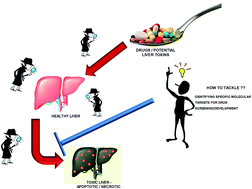Pathways involved in acetaminophen hepatotoxicity with specific targets for inhibition/downregulation
Abstract
The liver, a vital organ in our body, is highly prone to numerous diseases/disorders. The most prolific among the extensive array of liver disorders and challenging to the clinical/pharmaceutical industries is drug-induced hepatotoxicity. Acetaminophen (APAP), recommended as a first-line analgesic therapy and prescribed as an over-the-counter (OTC) medication, possesses an excellent safety profile when administered in therapeutic dosages, but hepatotoxicity can occur when overdosed during misuse/combinational therapy, that can be disastrous. It is well recognized that the pathogenesis of APAP induced hepatotoxicity involves the contribution of the parent drug/its metabolites [NAPQI (N-acetyl-p-benzoquinone imine)] that directly and/or indirectly modulate the bioenergetics of cells through various metabolic disturbances and immune reactions. In spite of the many recent scientific reports which have established various key signal transduction pathways, the streaming events involved in this mechanism are not easily monitored, which have the profound impact of challenging the clinical/pharmaceutical research. In compiling recent research perspectives, in this review, a flow of the chronological events involved in APAP hepatotoxicity, its molecular pathways and triggered immunological responses have been elucidated. This scientific information provides strong hypothetical rationale to create a vivid picture regarding the underlying pathogenesis of this disease and thereby establish new prophylactic/therapeutic interventions by targeting a few specific molecular targets, which have also been established from the signalling pathways. In brief, this review constructs/establishes the underlying mechanism of APAP induced hepatotoxicity and its molecular/immunological aspects based on the recent advancements in this research area.


 Please wait while we load your content...
Please wait while we load your content...